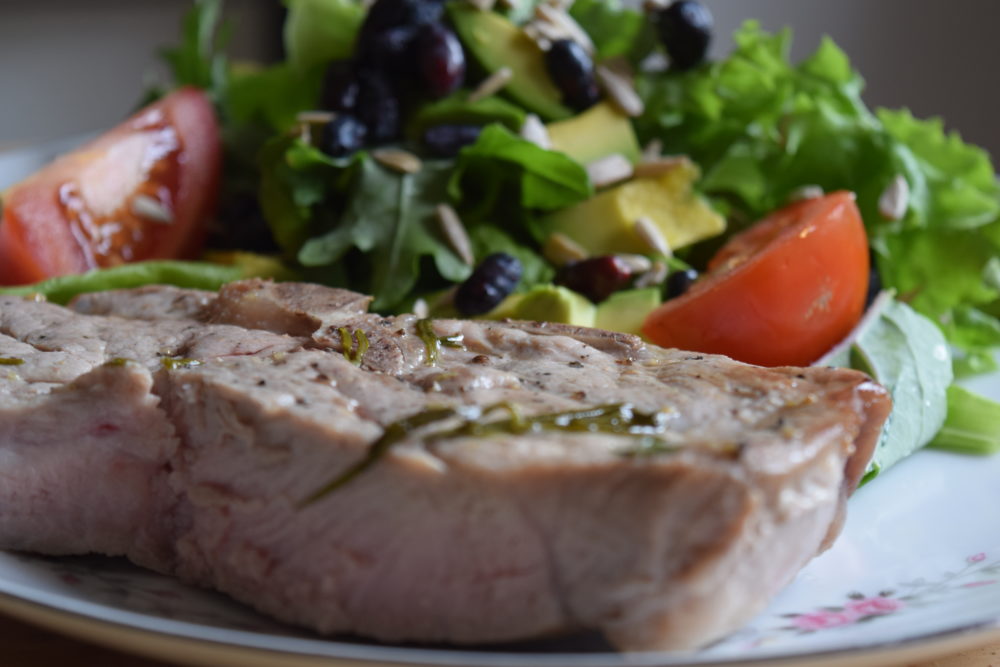Podcast: Play in new window | Download (Duration: 8:25 — 9.0MB) | Embed
Subscribe: Apple Podcasts | Android | Email | Stitcher | RSS | More
For my own well being I should mention, first, that unequivocally my mom is and always has been a good cook. For sure, there were a few experiments that went awry, but on the whole we ate exceptionally well. That is except for the pork chops. There was nothing good about a pork chop. They were dry, tough, and had as much flavour as a Jesus wafer on a Sunday morning. It didn’t matter who cooked it or whether you were eating at home or at your cousin’s wedding it tasted the same.
I stayed away from pork, well, I stayed away from pork except for bacon, ham, pork sausages, and other charcuterie meats. Because there is a big difference between pork and pork that has been salted, sugared, smoked, and spiced. The later is down right delicious. However, for the lowly pork chop and I we did not reconvene our disappointing relationship until I started working in the health food industry. It was at this point that I found out that pork was parasitical. Ahhh…what? I’ve had many a food revelation over the last few years and that was certainly one of them. For someone who grew up around pigs, who gently goaded them to “Pig Heaven” on Monday mornings, and tried to stomach them on Monday evenings I had no idea. I was also confused. We were selling humanely raised, pastured pork and yet folks were turning their nose up at the pork chops and the pork roasts, and, yet, still thoroughly enjoying their bacon. Was it because bacon was cured and delicious that you didn’t have to worry about getting parasites? And, if pork was so dangerous, why had I never heard of it before?
The disease is called Trichinosis, and it would probably be a good idea to premise the following by saying, “It is rare!” At least in North America. There are currently about twenty cases of Trichinosis in the United States a year. And, due to improved pig management there is now a greater chance of getting Trichinosis through the consumption of Wild Game than pigs. The disease is caused by eating undercooked meat of animals infected with the larvae of the Trichinella worm. According to the Centers for Disease Control and Prevention, “The signs, symptoms, severity and duration of trichinellosis vary. Nausea, diarrhea, vomiting, fatigue, fever, and abdominal discomfort are often the first symptoms of trichinellosis. Headaches, fevers, chills, cough, swelling of the face and eyes, aching joints and muscle pains, itchy skin, diarrhea, or constipation may follow the first symptoms. If the infection is heavy, patients may experience difficulty coordinating movements, and have heart and breathing problems. In severe cases, death can occur. For mild to moderate infections, most symptoms subside within a few months. Fatigue, weakness, muscle pain, and diarrhea may last for months.”
The Pigs success over the past ten thousand years of domesticated life is due mainly to its remarkable ability to adapt. Pigs are omnivorous and if left to their own whim will eat anything and that is the problem. The Trichinella worm is introduced into the Pig’s body through the pig eating other infected animals. Trichinosis was a consistent problem within our food chain up until the mid 1950s. Unfortunately, for those of us who are concerned about animal welfare and would like to support free-range, pastured animals it was the pork industry’s move towards the industrialized model that significantly lowered infection rates. Moving pigs from outdoors to confined spaces indoors allowed farmers to better control what the pig consumed–grains and more grains. Along with moving pigs into confined spaces the public was educated on the importance of cooking pork properly. Well, kind of! The Government of Canada, to this day, suggests that consumers cook pork to 160 degrees Fahrenheit. The USDA had the same recommendation until 2011 when it lowered it to 145 degrees. This is because 160 degrees results in dry, tough, flavourless pork. It wasn’t the pork chops fault. It was us all along. We were overcooking zealots, who let our fear get in the way of proper cooking. However, for some reason, our concern did not really transfer over to pork products that have been smoked or cured. According to the Centers for Disease Control and Prevention, “Curing (salting), drying, smoking, or microwaving meat alone does not consistently kill infective worms.” And, “homemade jerky and sausage were the cause of many cases of trichinellosis reported to the CDC in recent years.” So, the public is still confused and how we treat pork products can be rather contradictory in manner.
On top of this, the whole situation leaves us in a bit of a conundrum. Although all animals should be respected and valued, in terms of our domesticated animals pigs are particularly interesting creatures. In Mark Essig’s Lesser Beasts: A Snout to Tail History of the Humble Pig, the author tracks the historical story of the pig and it’s importance and influence on human civilization. He discusses the pigs innate ability to thrive in different locales, whether it be in forests, farms, or city streets. In Europe where pigs ate acorns in the forests and grain on the farms, pigs and their meat were unquestionably a part of society’s dietary routines. However, as we moved more east and pigs were found in city streets surviving off of food scraps, rats, dead things, and other unpleasantries pork was for the poor only as the rich deemed it unclean and unsightly. For the colonialists, pigs were a dependable source of food as they reproduced and adapted quickly to new lands. Spreading diseases to the native peoples while providing food for the newcomers. Pigs are one of the only hoofed animals that make a nest for their young. They wallow in the mud to moderate their temperature and prevent sunburn. They make sure to urinate and defecate away from their bedding. Their sense of smell is 2000 times better than ours, and their snout is not just a nose, but doubles as a fifth limb. The pig’s snout is similar to an Elephant’s trunk in its dexterity. Click here to listen to a CBC interview with Essig.
Considering the pig’s natural abilities it is deeply unfortunate that the majority of pigs in existence today exist in crowded pens on cement floors in enclosed buildings. Unable to live as pigs naturally live, they are there for our convenience, our consumption, and our health. It is all to very easy to condemn the industrialized farming model, which I have done on many occasions, however, it would be ignorant of us to not imagine that perhaps there were very good reasons for the creation of the industrialized model in the first place. Reasons that go beyond the all mighty dollar. According to Peter Davies in his article Intensive Swine Production and Pork Safety there is an “80-fold greater risk (per pig produced) of trichina infections resulting from eating niche market versus commercial pork products in [the United States]” Of course although the industrialized model solved this problem it also created many more that were unseen decades before. Yes, it is a conundrum. And maybe because the reality is unsatisfying is the reason for our mixed feelings towards pigs and their meat.

